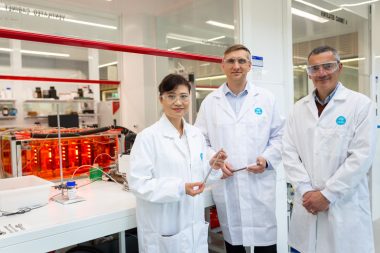The Queensland government is celebrating a milestone in its Central Queensland Hydrogen Project (CQ-H2) with investment by Singaporean infrastructure giant Keppel in a green ammonia production plant.

Keppel announced on Friday it had joined the CQ-H2 project consortium and signed an MoU with Australian chemicals and fertiliser company Incitec Pirvot to build an industrial-scale green ammonia production facility in Gladstone.
Green ammonia describes ammonia that is made using renewable and carbon free processes.
The MoU involves the development of up to around 850,000 tonnes of green ammonia a year, as well as related export facilities.
Domestic and international markets
The green ammonia will be supplied to Australian markets to support the decarbonisation of IPL’s domestic manufacturing assets, and also exported to Singapore to meet Keppel’s or low-emissions power generation needs.
Excess green ammonia would be marketed and sold to customers in Asia.
The parties will work closely with the Queensland government on infrastructure requirements, as well as licences and approvals around the production and export of green ammonia, Keppel says.
(This will) enable us to produce, store and transport green hydrogen and ammonia in a safe, scalable and cost competitive manner for end-users in Australia, Singapore and globally.
Cindy Lim
Keppel Infrastructure Division CEO Cindy Lim says the company’s involvement in CQ-H2 will help its efforts to turn green hydrogen and ammonia into “reliable and commercially viable energy sources” for domestic and overseas consumption.
“Keppel’s track record in developing and operating large-scale energy and environmental infrastructure combined with the expertise and experience of our partners will enable us to produce, store and transport green hydrogen and ammonia in a safe, scalable and cost competitive manner for end-users in Australia, Singapore and globally,” she said.
$117m investment
The Queensland and federal governments also announced on Friday they had partnered with consortium members in a $117 million investment to fund the Front End Engineering Design study for CQ-H2.
This is the largest green hydrogen investment of its kind in the nation’s history
Queensland Treasurer Cameron Dick
The Australian Renewable Energy Agency (ARENA) will provide $20 million, the Queensland government $15 million and the CQ-H2 consortium, comprising Iwatani Corporation, Kansai Electric Power Company, Marubeni Corporation and Queensland’s publicly owned Stanwell Corporation, will contribute $81.8 million.
“This is the largest green hydrogen investment of its kind in the nation’s history,” Queensland Treasurer Cameron Dick said.
Australia’s biggest hydrogen project
CQ-H2 is Australia’s largest green hydrogen project, while Gladstone has been identified as one of seven clean hydrogen hubs across the country in Australia’s National Hydrogen Strategy.
The CQ-H2 project involves the development of a Hydrogen Production Facility, hydrogen gas pipeline and Hydrogen Liquefaction Facility, as well supply of hydrogen to an ammonia production facility.
The project will be powered by renewable energy and will produce 200 tonnes of hydrogen a day by 2028, rising up to 800 tonnes a day by 2031.
The hydrogen will be liquified or converted to ammonia for export and potentially local industry offtake.
Commercial operations are planned to commence in 2028 with a final Investment decision expected in late 2024.
CSIRO develops new hydrogen generator
Meanwhile, the National Science Agency is developing a deployable hydrogen generator that will be able produce hydrogen at off-grid locations.
CSIRO scientists are building a demonstration unit that generates hydrogen from liquid carriers.
The carriers mean hydrogen can be transported in from where it’s produced – such as remote solar or wind farm – to the point of consumption.

The initiative is being supported by a $10 million investment from research company Advanced Carbon Engineering, and will be the first of its kind in Australia.
The technology addresses some of the key barriers to growing the nation’s hydrogen sector, CSIRO Deputy Hydrogen Industry Mission Lead Dr Vicky Au says.
“Australia has the potential to become an energy superpower through hydrogen, but we need to find better methods of safely transporting and storing it at scale,” she said.
“To get the hydrogen industry moving, we need to be able to get hydrogen where it will be used by the consumer. This generator unit will do just that and will be compact enough to move to where it’s needed – whether that’s a farm, a festival, an industrial facility or a mine site.”
The project is being delivered as a part of CSIRO’s Hydrogen Industry Mission, which is contributing to the establishment of a commercially viable Australian hydrogen industry.
*Main image: Artist impression of the proposed hydrogen supply chain (Stanwell)





Why? Australia has the 3rd highest deposits of Uranium. We have 3 uranium mines and one Nuclear Reactor. We are committed to nuclear submarines in the future.
Nuclear Power stations have been around for 69 years since 1954. Currently 31 countries use nuclear power.